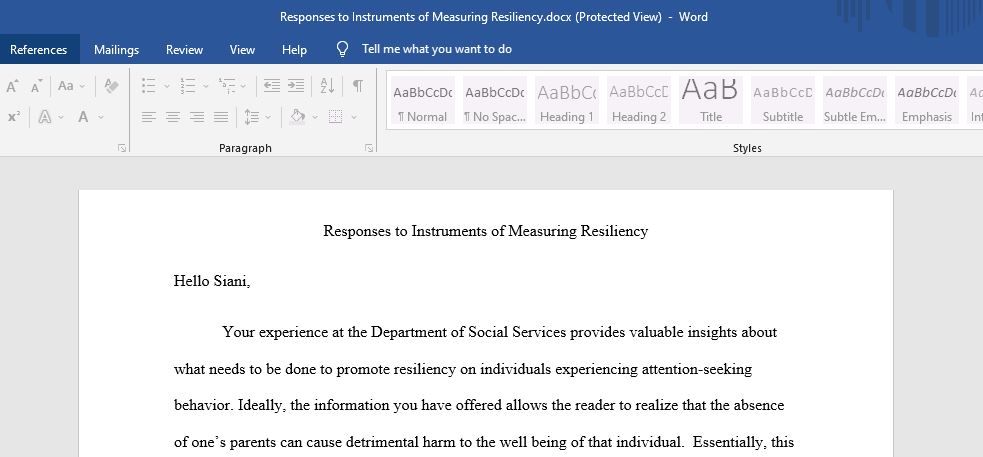Responses to Instruments of Measuring Resiliency
Respond to two colleagues:
- Discuss how you would use the data collected by your colleague to guide the next step in the planned change process or to inform future work with clients.
Colleague 1: Siani
Fieldwork Experience and Identify a Case using Resiliency Theory
During my undergrad experience while interning at the Department of Social Services, I work with an adolescent male who was going down the wrong path at a young age. His behaviors reflect attention seeking behaviors due the absences of his mother and father.
Describe the presenting problem in one concise sentence
The client’s presenting problem reflected attention seeking behaviors that seem to stem from the absence of his mother and his father.
Describe an intervention you would implement to promote resiliency
The intervention used that will promote resiliency is an adolescent transition program. This program will help to reduce problem behaviors. The intervention can be done in a school setting or family environment. It focuses on behavior change, communication skills, and much more.
Identify an instrument from the Smith-Osborne and Whitehill Bolton’s article
Predictive 6-Factor Resilience Scale is an instrument from the Smith-Osborne and Whitehill Bolton’s article.
Explain why you selected the instrument
I chose this instrument because I feel this instrument will clearly justify the client’s behavior problem and guide the social worker and the parents to the next obstacle that needs to work on. This particular scale is based on six domains. Each domain will allow the social worker to view each step and gradually examine the clients needs and combine them with what the instrument has to offer.
Smith-Osborne, A., & Whitehill Bolton K. (2013). Assessing resilience: A review of measures across the life course. Journal of Evidence-Based Social Work, 10(2), 111–126. doi:10.1080/15433714.2011.597305
Colleague 2: Penelope
The case study I selected for this discussion is based on 55 years of age, single, Caucasian male referred to as John Doe. John was hospitalized for frequent falls due to his limited mobility. His medical history consists of strokes, congestive heart failure, depression, alcoholism, and sleep apnea. John’s hospital discharge states he will require assistance with personal hygiene and household chores. He has become socially isolated due to his common-law wife living with her children, is estranged from his only daughter, and is in jeopardy of becoming homeless.
Description of John Dow’s Strengths
John’s strengths consist of him adapting to limited mobility by being resourceful. For example, he placed his laundry basket on his lap while sitting in his electric wheelchair to the elevator from the second floor to the basement to do his laundry. He uses an electric hot plate in his living room to cook his meals instead of his stove and uses handicap accessible public transportation to and from his medical appointments. John has his medications delivered by his local pharmacy, coordinated with the post office to hold his mail for Friday for his mail carrier to return to his door. His neighbor checks on him helps with his shopping and household chores when available. He receives SS income, some savings, Medicare no criminal history.
Presenting Problem in One Concise Sentence
John stated, “I have no place to go,” due to his common-law wife’s children not wanting him living with them and his PCP has not completed his referral for him to relocate to a skilled nursing facility.
An Intervention I Would Implement to Promote Resiliency
John, unfortunately, did not qualify for additional support services with the Mississippi Division of Medicaid. Due to not qualifying with Medicaid, a referral was made to the Division of Aging and Adult Services (DAAS) with the Mississippi Department of Human Services. Also, his assessment was forwarded to his PCP to determine John’s eligibility for a nursing facility. John was informed he would not be allowed to consume alcohol when he’s in a nursing facility. John stated he was willing to give it up if it meant he would have a place to live. In addition, we discussed the increase of social support and activities he could have while living in a nursing facility.
Identified Instrument from the Smith-Osborne and Whitehill Bolton’s Article to Employ in John’s Case
In John’s case, I would employ the Conner-Davidson Resilience Scale (CD-RICS) as the most appropriate instrument to use in a single-subject designed to evaluate how effective the intervention of increasing the level of John’s resiliency and overall wellbeing (Smith-Osborne, A., & Whitehill Bolton K. 2013).
Reason for Selected Instrument
The CD-RICS was normed on adults that include “general population, primary care, psychiatric outpatients, had a generalized anxiety disorder, and PTSD (Smith-Osborne, A., & Whitehill Bolton K. 2013). The scale of cross-cultural validation measures both intrapsychic and contextual protective factors, including full constructs to measure and monitor treatment interventions. The validation sample was also appropriate in size (n=806) (Smith-Osborne, A., & Whitehill Bolton K. 2013).
Reference:
Smith-Osborne, A., & Whitehill Bolton K. Assessing resilience: A review of measures across the life course. Journal of Evidence-Based Social Work, 10(2), 111-126. doi:10.1080/15433714.2011.597305
Answer preview:

word limit:591
